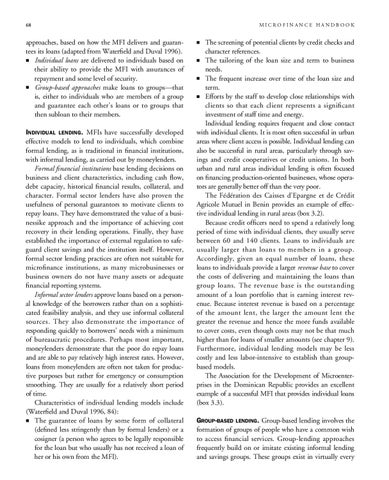MICROFINANCE HANDBOOK
68
approaches, based on how the MFI delivers and guarantees its loans (adapted from Waterfield and Duval 1996). ■ Individual loans are delivered to individuals based on their ability to provide the MFI with assurances of repayment and some level of security. ■ Group-based approaches make loans to groups—that is, either to individuals who are members of a group and guarantee each other’s loans or to groups that then subloan to their members. INDIVIDUAL LENDING. MFIs have successfully developed effective models to lend to individuals, which combine formal lending, as is traditional in financial institutions, with informal lending, as carried out by moneylenders. Formal financial institutions base lending decisions on business and client characteristics, including cash flow, debt capacity, historical financial results, collateral, and character. Formal sector lenders have also proven the usefulness of personal guarantors to motivate clients to repay loans. They have demonstrated the value of a businessike approach and the importance of achieving cost recovery in their lending operations. Finally, they have established the importance of external regulation to safeguard client savings and the institution itself. However, formal sector lending practices are often not suitable for microfinance institutions, as many microbusinesses or business owners do not have many assets or adequate financial reporting systems. Informal sector lenders approve loans based on a personal knowledge of the borrowers rather than on a sophisticated feasibility analysis, and they use informal collateral sources. They also demonstrate the importance of responding quickly to borrowers’ needs with a minimum of bureaucratic procedures. Perhaps most important, moneylenders demonstrate that the poor do repay loans and are able to pay relatively high interest rates. However, loans from moneylenders are often not taken for productive purposes but rather for emergency or consumption smoothing. They are usually for a relatively short period of time. Characteristics of individual lending models include (Waterfield and Duval 1996, 84): ■ The guarantee of loans by some form of collateral (defined less stringently than by formal lenders) or a cosigner (a person who agrees to be legally responsible for the loan but who usually has not received a loan of her or his own from the MFI).
The screening of potential clients by credit checks and character references. ■ The tailoring of the loan size and term to business needs. ■ The frequent increase over time of the loan size and term. ■ Efforts by the staff to develop close relationships with clients so that each client represents a significant investment of staff time and energy. Individual lending requires frequent and close contact with individual clients. It is most often successful in urban areas where client access is possible. Individual lending can also be successful in rural areas, particularly through savings and credit cooperatives or credit unions. In both urban and rural areas individual lending is often focused on financing production-oriented businesses, whose operators are generally better off than the very poor. The Fédération des Caisses d’Epargne et de Crédit Agricole Mutuel in Benin provides an example of effective individual lending in rural areas (box 3.2). Because credit officers need to spend a relatively long period of time with individual clients, they usually serve between 60 and 140 clients. Loans to individuals are usually larger than loans to members in a group. Accordingly, given an equal number of loans, these loans to individuals provide a larger revenue base to cover the costs of delivering and maintaining the loans than group loans. The revenue base is the outstanding amount of a loan portfolio that is earning interest revenue. Because interest revenue is based on a percentage of the amount lent, the larger the amount lent the greater the revenue and hence the more funds available to cover costs, even though costs may not be that much higher than for loans of smaller amounts (see chapter 9). Furthermore, individual lending models may be less costly and less labor-intensive to establish than groupbased models. The Association for the Development of Microenterprises in the Dominican Republic provides an excellent example of a successful MFI that provides individual loans (box 3.3). ■
GROUP-BASED LENDING. Group-based lending involves the formation of groups of people who have a common wish to access financial services. Group-lending approaches frequently build on or imitate existing informal lending and savings groups. These groups exist in virtually every
